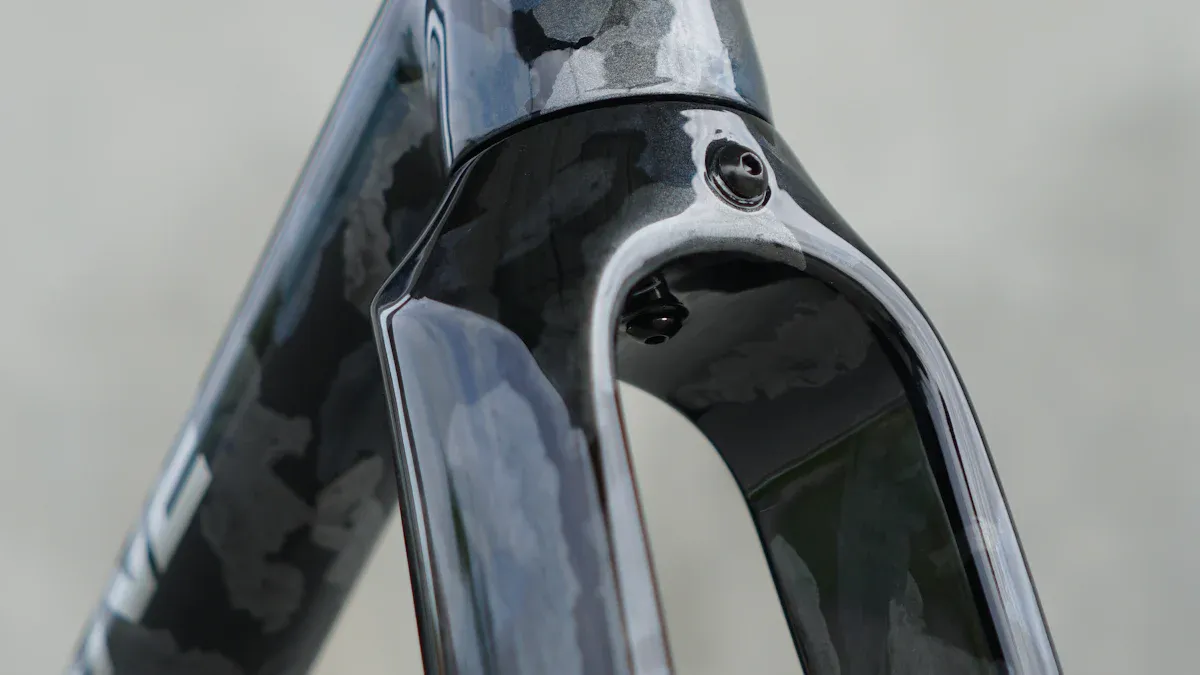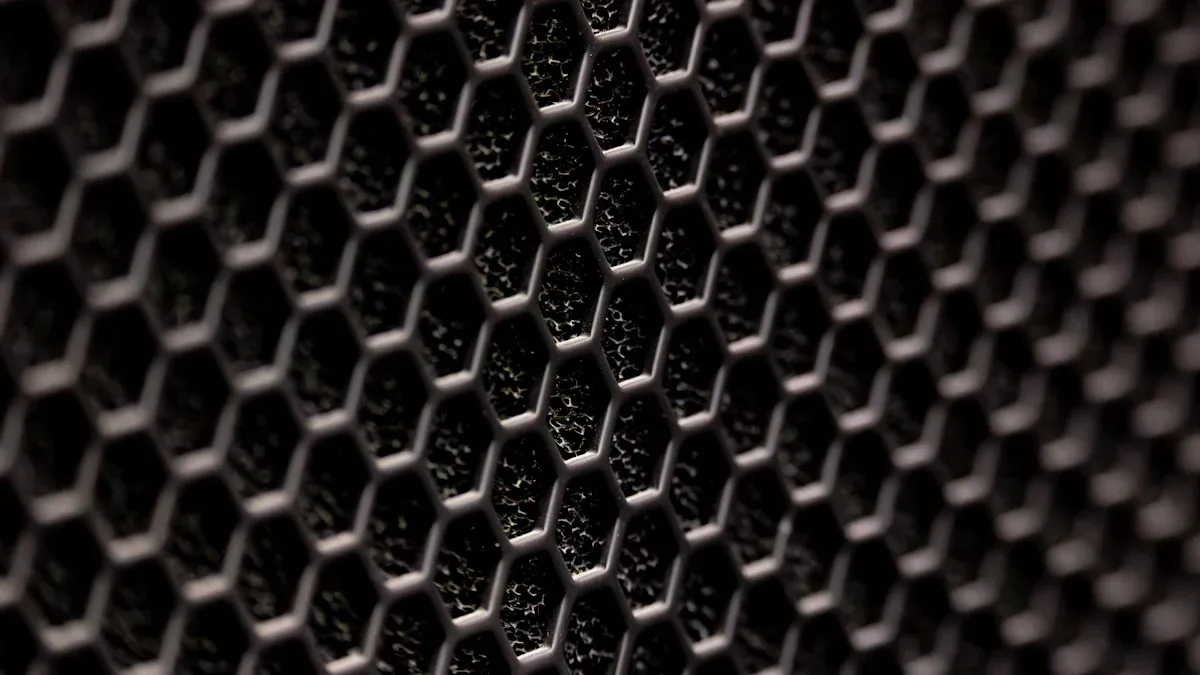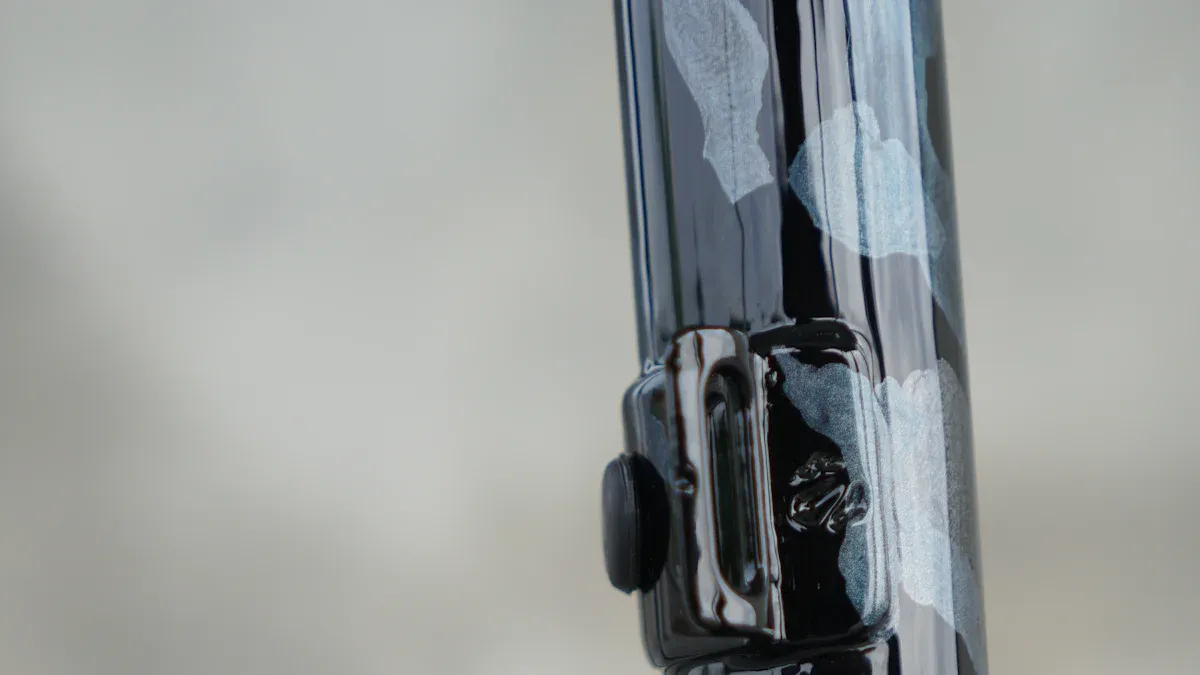
Carbon bike frames have become very popular. They attract both pro cyclists and fans. Their strong yet light design makes them a great choice for fast bikes. It is important to understand how these frames are made. This knowledge affects both how well the bike performs and how safe it is. Recent studies show that learning about carbon bike frame construction helps you value the skill that goes into making your bike.
Key Takeaways
Carbon fiber is strong and light. This makes bikes faster.
Knowing how bikes are built, like monocoque and tube-to-tube, helps you pick the best bike for you.
Quality control is very important. Testing makes sure your bike is safe and lasts long.
Buying a good carbon frame improves how well your bike works. It also makes your rides more fun.
Think about weight, shape, and how the bike is made when choosing your next bike for the best performance.
Carbon Fiber Properties

When you think about bike frames, carbon fiber is special. Knowing its features helps you see why many cyclists like carbon fiber more than other materials.
Strength and Weight
Carbon fiber has a great strength-to-weight ratio. This means you get a light frame that is still strong. In fact, carbon fiber can be five times stronger than steel and 70% lighter. Here’s a quick look at different materials:
Material | Strength-to-Weight Ratio | Weight Comparison |
|---|---|---|
Carbon Fiber | Best | |
Aluminum | Stronger than Steel | Lighter than Steel |
Steel | Heaviest | Heavier than Aluminum |
This high strength-to-weight ratio makes carbon fiber a top choice for serious riders. You can go faster and handle better without extra weight.
Flexibility and Durability
Carbon fiber also has great flexibility and durability. It can soak up shocks and vibrations, giving you a smoother ride. But, it’s important to know that how long carbon fiber lasts depends on a few things. Dr. Rinard says that well-made carbon fiber bike frames can last for many years. Good layup methods and avoiding extreme conditions are key for keeping them strong.
Here are some things that affect how long carbon fiber lasts:
Factor | Description |
|---|---|
Quality of Carbon Fiber | Better grades of carbon fiber last longer. |
Resin Quality | The type of resin used affects the frame’s life. |
Craftsmanship | Bad manufacturing can make it less durable. |
While carbon fiber frames are strong, they can get damaged from impacts or extreme temperatures. Repeated stress can also cause wear over time. Knowing these features helps you choose the right bike frame.
Carbon Bike Frame Construction Steps

Making a carbon bike frame has several important steps. Each step is key to making the frame strong, light, and perform well. Knowing these steps helps you see the skill behind high-quality carbon fiber bikes.
Weaving and Cutting
The first step is weaving the carbon fiber. Makers use different patterns to get certain performance traits. Here’s a quick look at common weave types:
Weave Type | Description | Performance Impact |
|---|---|---|
Plain Weave | Tows are woven over and under in a pattern, making a checkerboard look. | Gives stability and accuracy; great for flat areas with fewer curves. |
Twill Weave | Diagonal pattern that is more flexible and looks smoother. | Looks nicer; used in parts where appearance matters. |
Satin Weave | Smooth surface with fewer cross points, easier to shape over curves. | Balances flexibility and strength; good for complex shapes. |
Uni-Directional (UD) | Fibers lined up in one direction, giving strength that way. | Very strong and stiff along the fiber; weaker across it. |
After weaving, makers cut the pre-preg carbon sheets into specific shapes. They place these pieces in a mold based on a layup plan. This careful setup improves the frame’s strength and weight.
Lay-Up and Molding
Once the pieces are cut, the next step is the lay-up process. During lay-up, engineers wrap the carbon strips around a core. This core goes into a heated press. The heat helps the resin flow and packs the material, removing air pockets. This step is vital for getting the right structure. It helps avoid weak spots and ensures a good finish.
The molding step often uses high-pressure methods, like Mandrel Wrapping in an Autoclave. This technique makes sure there are few voids and even resin spread, which boosts the frame’s strength while cutting down weight. The first curing step is key for getting the right performance. After curing, the frame parts are glued together and wrapped with more carbon fiber for extra support.
Construction Methods
When building carbon fiber bike frames, two main methods are popular: the monocoque design and the tube-to-tube method. Each method has its own pros and cons. These differences can change how the frame performs, its weight, and its cost. Knowing these details helps you choose the right bike.
Monocoque Design
The monocoque design makes the frame as one piece. This method makes the frame stronger and has fewer weak spots. Here are some key benefits of the monocoque design:
Structural Integrity: Monocoque frames have great strength. They are made in one mold, so there are no joints that can break.
Performance: The light frame helps with quick movements. It is stiff and strong, which improves handling and power when pedaling.
Cost Efficiency: The first costs can be high, but making many monocoque frames is cheaper. This makes them a favorite for high-performance carbon fiber bikes.
However, monocoque frames might not handle impacts as well as tube-to-tube designs. They can be more easily damaged in crashes or rough use.
Tube-to-Tube Method
The tube-to-tube method connects separate carbon fiber tubes. This way of building allows for more customization and can create a stronger frame. Here are some important points about the tube-to-tube method:
Customization: You can change the frame shape to fit different riding styles. This can make riding more comfortable and improve performance.
Robustness: Tube-to-tube frames are usually stronger against impacts. They can handle damage better than monocoque frames because of their design.
Cost Considerations: While tube-to-tube building can lower initial costs, it often makes the bike heavier. The process takes more time and work, which can raise production costs.
Here’s a quick comparison of the two methods:
Construction Method | Structural Integrity | Robustness Against Impacts |
|---|---|---|
Monocoque | Stronger because it is one piece | Not as strong as tube-to-tube |
Tube-to-Tube | Can be customized, usually stronger against impacts | More durable, can resist damage and wear over time |
Advanced Techniques
Braided Carbon Structure
The Braided Carbon Structure (BCS) is a big step forward in carbon bike frame technology. This new method uses different diagonal patterns of unidirectional carbon fibers. This design makes the frame stronger and balances the forces throughout it. Unlike older carbon fiber methods, BCS lets makers create custom designs that boost performance.
Here’s a quick comparison of BCS and traditional methods:
Feature | Braided Carbon Structure | Traditional Carbon Fiber Lay-Up |
|---|---|---|
Architectural Flexibility | High – allows for tailored designs | Limited – typically fixed layers |
Damage Tolerance | Improved – cracks navigate complex paths | Lower – cracks travel between layers |
Manufacturing Efficiency | High – single integrated components | Lower – requires multiple parts and assembly |
Benefits of BCS
The benefits of using BCS in bike frame building are impressive. First, the braided design helps with damage tolerance. Cracks can move through complex paths, which helps keep the frame strong. This feature is very important for cyclists who ride in tough conditions.
Also, BCS makes manufacturing more efficient. The process creates single parts, cutting down the need for many pieces. This efficiency leads to lighter frames without losing strength.
Research shows that the 1/1 braid structure spreads damage more evenly than the 2/2 structure. This even spread helps keep strength during twisting. The use of advanced carbon fiber technology, like Resin Transfer Molding (RTM), ensures a steady carbon structure. This steadiness makes the overall frame even stronger.
Quality Control in Frame Production
Quality control is very important in making carbon bike frames. It makes sure that every frame is safe and works well. You want to be sure your bike can handle the road. Manufacturers use different tests to check for strength and performance.
Durability Testing
Before a carbon bike frame is sold, it goes through tough durability tests. Here are some common tests done:
Checking molded parts with a visual inspection before bonding.
A complete check on frame alignment after bonding.
Surface quality checks before painting.
Looking for finish defects after painting.
Random sampling to test stiffness on frames and forks.
These tests help find problems, like wrinkles in the carbon or areas where layers are not smooth. Issues like these can cause failures when riding.
Performance Assessments
Manufacturers also do performance assessments to make sure the frames can handle real-life conditions. They focus on several quality control steps, including:
Description | |
|---|---|
Incoming Goods Inspection | Checking raw materials and parts to meet standards. |
Quality Controls Between Departments | Checks during processing stages like CNC machining and surface finishing. |
X-ray Fluoroscopy | Non-destructive testing to find internal defects. |
Mechanical Testing | Load tests to check the strength and durability of the frame. |
Final Inspection | Detailed checks recorded in a test report before finishing. |
Lightcarbon, a top manufacturer, uses a rating system from Z11 to Z3 for quality checks. Criterion A looks at frame material quality, while Criterion C checks geometry. This organized approach helps make sure you get a high-quality product.
By knowing these quality control steps, you can see the skill behind your carbon bike frame. Understanding that your bike has passed tough tests gives you confidence in its performance and safety on the road.
In conclusion, learning about carbon bike frame construction shows how these fast bikes are made. Here are the main points:
Carbon Fiber Properties: Its strength-to-weight ratio helps with speed and control.
Construction Methods: Monocoque and tube-to-tube designs have different advantages.
Quality Control: Strict testing makes sure the bike is strong and safe.
Good construction affects how long your bike lasts and how safe it is. Experts say that careful layering and good resin are important for strength.
Value the work that goes into your bike. Each frame shows advanced technology and skilled work, making your rides enjoyable.
Think about weight, shape, and building methods when picking your next bike. Investing in a well-made carbon frame gives you better performance and longer use. 🚴♂️
FAQ
What is carbon fiber?
Carbon fiber is a light material made from thin strands of carbon atoms. It is very strong and stiff, which makes it great for bike frames. Many cyclists like it because it performs well and lasts a long time.
How does carbon fiber compare to aluminum?
Carbon fiber is lighter and stronger than aluminum. It also absorbs vibrations better, giving you a smoother ride. However, aluminum frames can be cheaper and easier to fix if they get damaged.
Can carbon bike frames be repaired?
Yes, carbon bike frames can be fixed, but it needs special skills. Experts use advanced carbon fiber methods to repair cracks or damage. Always talk to a professional for repairs to keep your bike safe and performing well.
How long do carbon bike frames last?
With good care, carbon bike frames can last for many years. Things like riding conditions, maintenance, and how well they are made affect how long they last. Regular checks help find any problems early.
Are carbon bike frames worth the investment?
Yes, carbon bike frames give you better performance, save weight, and provide comfort. Even though they might cost more at first, their benefits often make them worth it for serious cyclists.
See Also
Exploring The Innovations In Carbon Fiber Bicycle Frames
The Role Of Science In Fixing Carbon Bike Frames
Transitioning From Iron To Carbon In Single Gear Bikes
